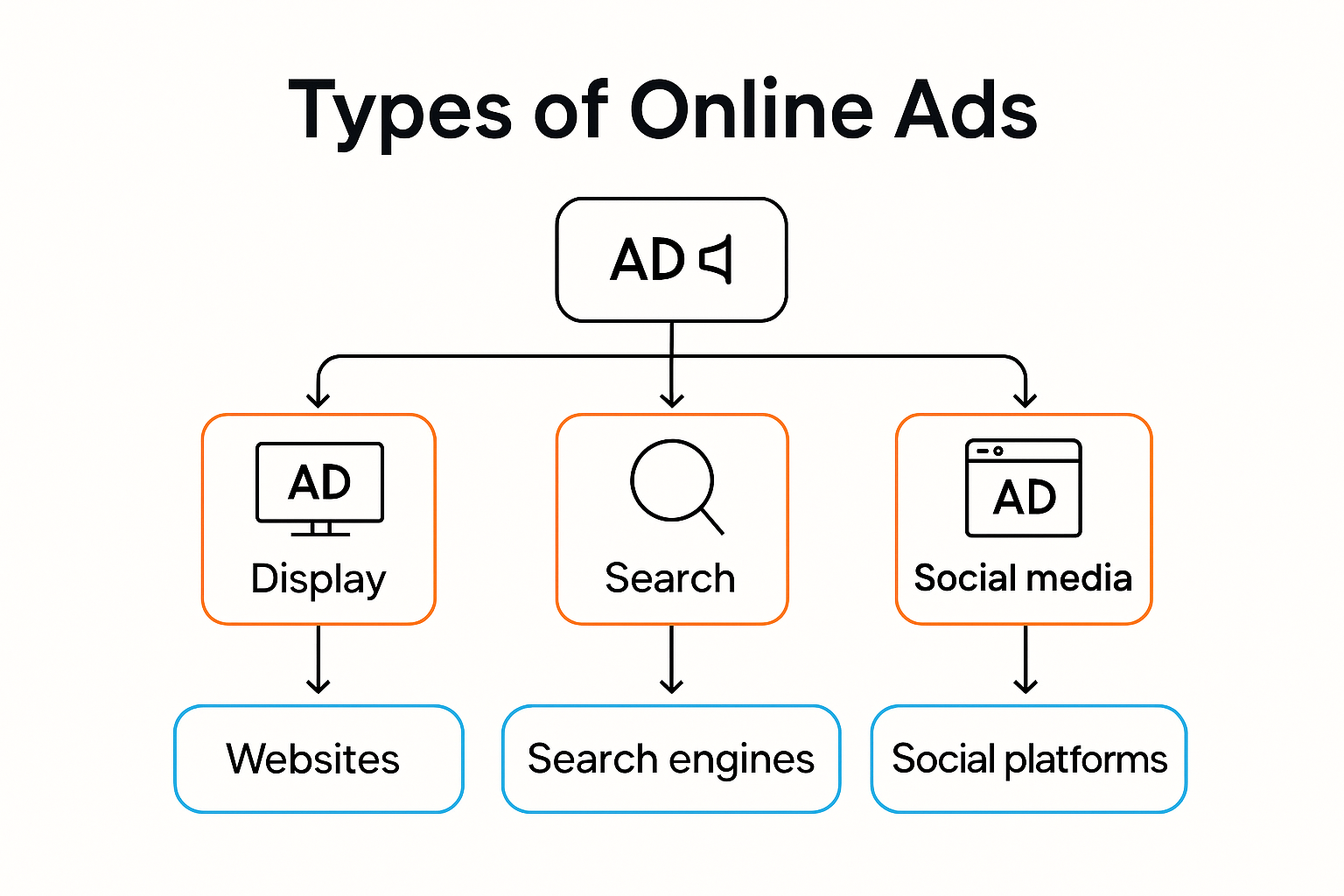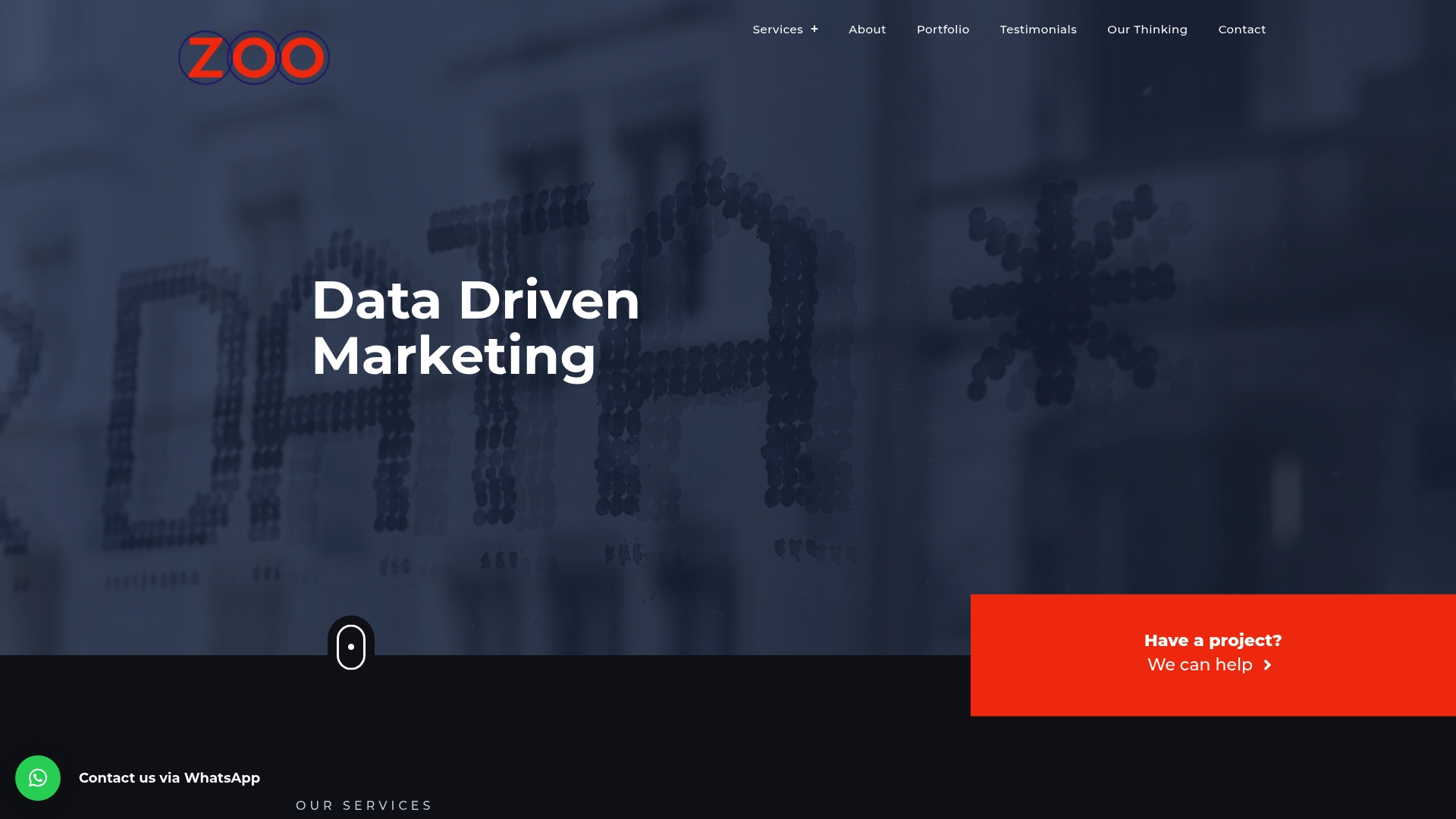
Online advertising looks like a maze for small businesses, but right now digital ads are more accessible than ever. Here’s a shocker. Nearly 80 percent of small businesses already invest in online advertising, and many start with just a few hundred rand. Most people think you need huge budgets or technical know-how to make a dent, but the real secret is that careful targeting and ongoing tweaks can put small brands on the same playing field as the big guys.
Table of Contents
- Understanding Online Advertising Basics
- Choosing The Right Platforms For Your Goals
- Setting Up Your First Online Ad Campaign
- Measuring Success And Improving Results
Quick Summary
| Takeaway | Explanation |
|---|---|
| Target Audience is Key | Developing detailed customer profiles and engaging in audience research are crucial for successful online advertising, allowing for tailored campaigns that resonate with the right demographics. |
| Define Clear Objectives | Establishing specific, measurable marketing goals guides both platform selection and campaign design, influencing overall effectiveness and performance tracking. |
| Monitor and Optimize | Regularly review campaign performance using Key Performance Indicators (KPIs) like CPA and CTR, adjusting strategies based on data to improve results continuously. |
| Choose the Right Platforms | Selecting appropriate advertising channels like social media or search engines based on audience demographics and business goals is essential for reaching the right customers efficiently. |
| Iterate and Adapt | Online advertising is not a one-time effort; it requires ongoing adjustments and testing to stay competitive in a rapidly evolving digital landscape. |
Understanding Online Advertising Basics
Online advertising represents a powerful digital strategy for small businesses seeking targeted customer engagement and growth. Understanding its fundamental principles allows entrepreneurs to navigate the complex world of digital marketing effectively.
What is Online Advertising?
Online advertising involves promoting products, services, or brands through digital channels to reach potential customers. Unlike traditional marketing methods, digital platforms offer unprecedented precision in targeting and measuring campaign performance. Research from the US Chamber of Commerce reveals that digital advertising enables businesses to connect with audiences more strategically than ever before.
The digital advertising ecosystem encompasses multiple channels including search engines, social media platforms, websites, and mobile applications. Each channel offers unique advantages for reaching specific audience segments. Paid search ads, for instance, appear alongside search results when users look for relevant keywords, while social media ads can target users based on demographics, interests, and online behaviors.

Key Components of Effective Online Advertising
Successful online advertising relies on several critical components. Audience targeting sits at the core of digital marketing strategies. Business Gateway research emphasizes the importance of developing detailed customer profiles to ensure your advertising messages resonate with the right people.
A Unique Selling Proposition (USP) distinguishes your advertising efforts. This concise statement communicates why potential customers should choose your business over competitors. The Hartford’s small business guide suggests that a clear USP helps create consistent and compelling advertising messages across different digital platforms.
Measurement and analytics play a crucial role in online advertising. Modern digital platforms provide robust tracking tools that allow businesses to monitor key performance indicators such as click-through rates, conversion rates, and return on ad spend. This data-driven approach enables continuous optimization of advertising strategies.
Selecting the Right Advertising Channels
Choosing appropriate digital advertising channels depends on your business goals, target audience, and budget. Search engine advertising through platforms like Google Ads works well for businesses seeking immediate visibility. Social media advertising on platforms like Facebook, Instagram, and LinkedIn offers granular targeting options.
For small businesses just starting, explore our guide on digital media strategies to understand which channels might best suit your specific marketing objectives. Different platforms serve different purposes: some excel at brand awareness, while others drive direct sales or website traffic.
The digital advertising landscape continues evolving rapidly. Staying informed about emerging trends, platform updates, and consumer behavior shifts is essential for maintaining an effective online advertising strategy. Small businesses that adapt quickly and leverage data-driven insights will gain a competitive edge in the dynamic digital marketplace.
Choosing the Right Platforms for Your Goals
Selecting the appropriate online advertising platforms requires strategic planning and a deep understanding of your business objectives. The digital marketing landscape offers numerous channels, each with unique strengths and targeting capabilities.
Defining Your Marketing Objectives
Before diving into platform selection, businesses must establish clear and specific marketing goals. Research from the US Chamber of Commerce emphasizes that well-defined objectives guide platform choice and campaign design. These objectives might include increasing brand awareness, generating leads, driving website traffic, or directly generating sales.
Small businesses should prioritize goals that align with their current growth stage. A startup might focus on brand visibility, while an established business could target direct conversions. Each goal requires a different approach and platform strategy. Performance metrics will vary based on these objectives, making it crucial to select platforms that offer appropriate tracking and reporting tools.
Understanding Platform Characteristics
Different online advertising platforms cater to specific audience segments and offer varied advertising formats. Social media platforms like Facebook and Instagram excel at demographic targeting and visual storytelling. Search engine advertising through Google Ads provides intent-based targeting, capturing users actively searching for relevant products or services.
Business research suggests evaluating platforms based on several key factors:
- Audience demographics: Match platform user base with your target customer profile
- Cost structures: Compare pricing models like pay-per-click or impression-based
- Targeting capabilities: Assess granularity of audience segmentation
- Ad format flexibility: Determine which platforms support your preferred content types
Below is a comparison table to help you scan the unique strengths of major online advertising platforms as described above.
| Platform Type | Main Strengths | Targeting Capabilities | Suitable For |
|---|---|---|---|
| Social Media (Facebook, Instagram) | Demographic targeting, Visual storytelling | High (demographics, interests, behaviour) | Brand awareness, engagement |
| Search Engines (Google Ads) | Intent-driven, High visibility | High (keywords, location, device) | Direct sales, lead generation |
| Websites/Display Networks | Broad reach, Brand exposure | Moderate (placements, topics) | Awareness, remarketing campaigns |
| Mobile Apps | On-the-go engagement, Young audiences | Varies (age, behaviour, location) | App installs, engagement |
Strategic Platform Selection
Successful platform selection involves comprehensive audience research and platform evaluation. Comprehensive digital marketing insights recommend a multi-platform approach that diversifies your digital marketing strategy.
Consider platforms that offer:
- Robust analytics and tracking
- Flexible budgeting options
- Advanced targeting capabilities
- Integration with your existing marketing tools
Learn more about our digital media strategies to understand how professional guidance can streamline your platform selection process. Each platform presents unique opportunities and challenges, requiring continuous learning and adaptation.
Remember that platform effectiveness evolves rapidly. What works today might change tomorrow. Regular performance reviews, staying updated on platform features, and remaining agile in your approach will help maintain a competitive digital advertising strategy.
Small businesses should start with 1-2 platforms that best match their goals and gradually expand their digital advertising footprint. Experimentation, careful tracking, and data-driven decision-making are key to finding the most effective online advertising platforms for your specific business needs.

Setting Up Your First Online Ad Campaign
Launching your first online advertising campaign requires careful planning, strategic thinking, and a methodical approach. Small businesses can transform their digital marketing efforts by understanding the fundamental steps involved in creating an effective ad campaign.
Defining Campaign Objectives
Research from Digital Marketing Experts emphasizes the importance of establishing clear, measurable objectives before initiating an online ad campaign. These goals should be specific, actionable, and aligned with your broader business strategy.
Typical campaign objectives might include:
- Increasing website traffic
- Generating qualified leads
- Boosting product sales
- Enhancing brand awareness
Each objective requires a different approach and will influence your targeting, ad design, and performance metrics. Specific goals enable more precise measurement and provide a benchmark for evaluating campaign success.
Audience Research and Targeting
Comprehensive audience research is crucial for creating resonant advertising campaigns. Understanding your target demographic involves analyzing characteristics such as age, location, interests, online behaviors, and purchasing patterns.
Effective audience targeting allows businesses to:
- Reduce advertising waste
- Increase ad relevance
- Improve conversion rates
- Optimize marketing budgets
Utilize platform-specific targeting tools to create detailed audience segments. Most digital advertising platforms offer advanced targeting options that enable precise audience selection based on multiple parameters.
Campaign Implementation and Optimization
Small business marketing research highlights the importance of continuous monitoring and optimization. Start with a modest budget and gradually scale your campaign as you understand its performance.
Key implementation steps include:
- Crafting compelling ad copy
- Designing visually appealing creative assets
- Setting appropriate bid strategies
- Establishing conversion tracking
Explore our digital media strategies for professional guidance on implementing successful online advertising campaigns. Regular performance reviews allow you to adjust targeting, refine messaging, and improve overall campaign effectiveness.
Remember that online advertising is an iterative process. What works today might require modification tomorrow. Successful campaigns demand flexibility, data-driven decision-making, and a willingness to experiment. By maintaining a strategic approach and staying informed about digital marketing trends, small businesses can develop powerful online advertising strategies that drive meaningful business growth.
Below is a table that summarises the essential steps to set up your first online ad campaign, as discussed in the section above.
| Step | Description | Goal/Purpose |
|---|---|---|
| Define Objectives | Set clear, measurable campaign goals | Guide strategy and measurement |
| Conduct Audience Research | Analyse demographics, interests, behaviours | Identify and target the right users |
| Craft Ad Copy & Creatives | Develop compelling text and visuals | Capture attention, drive action |
| Select Platforms & Set Budgets | Choose channels, allocate spend | Maximise reach and efficiency |
| Implement Targeting & Launch Campaign | Use platform tools to select audience & go live | Reach the intended customers |
| Monitor, Optimise & Review Performance | Track KPIs, adjust and improve based on data | Boost results, reduce wastage |
Measuring Success and Improving Results
Successful online advertising goes beyond creating compelling campaigns. Measuring performance and continuously improving strategies are critical for small businesses seeking sustainable digital marketing growth.
Understanding Key Performance Indicators
Research from Queensland Business Resources emphasizes the importance of developing a comprehensive digital tracking strategy. Key Performance Indicators (KPIs) provide actionable insights into campaign effectiveness, allowing businesses to make data-driven decisions.
Critical metrics small businesses should track include:
- Cost per Acquisition (CPA)
- Click-through Rates (CTR)
- Conversion Rates
- Return on Ad Spend (ROAS)
- Website Traffic Generated
OpenStax Marketing Research highlights that each metric offers unique insights. Cost per Acquisition reveals the total expense of securing a new customer, while Click-through Rates demonstrate how engaging your ad content appears to potential customers.
Below is a summary table outlining the main digital advertising KPIs mentioned above, along with what each measures.
| KPI | What It Measures | Why It Matters |
|---|---|---|
| Cost per Acquisition (CPA) | Cost to acquire a new customer through ads | Assesses efficiency of spending |
| Click-through Rate (CTR) | Percentage of people who click the ad | Indicates ad relevance and engagement |
| Conversion Rate | Percentage of visitors who complete a desired action | Measures effectiveness of campaigns |
| Return on Ad Spend (ROAS) | Revenue generated for every rand spent on ads | Tracks profitability of campaigns |
| Website Traffic Generated | Number of site visits from advertising | Shows reach and awareness driven |
Implementing Tracking and Analytics
Small Business Digital Marketing Insights recommend utilizing robust analytics tools to monitor campaign performance. Google Analytics provides comprehensive tracking capabilities that enable businesses to understand user behavior, traffic sources, and conversion pathways.
Effective tracking involves:
- Setting up conversion tracking pixels
- Creating custom dashboards
- Establishing baseline performance metrics
- Configuring goal tracking
- Monitoring real-time campaign performance
Continuous Optimization Strategies
Successful digital advertising requires ongoing refinement. Businesses should adopt an iterative approach, consistently analyzing performance data and making strategic adjustments. This might involve:
- A/B testing ad variations
- Refining audience targeting
- Adjusting bidding strategies
- Reallocating budget to high-performing channels
Learn more about our digital media optimization techniques to understand how professional guidance can elevate your advertising performance. Regular performance reviews transform data into actionable strategies, ensuring your online advertising remains competitive and effective.
Remember that digital marketing is dynamic. What works today might require modification tomorrow. Successful businesses remain adaptable, using data as a compass for continuous improvement. By maintaining a systematic approach to measurement and optimization, small businesses can develop increasingly sophisticated and successful online advertising strategies that drive meaningful business growth.
Frequently Asked Questions
What is online advertising?
Online advertising involves promoting products, services, or brands through digital channels to reach potential customers. It allows businesses to connect with their audiences more strategically compared to traditional marketing methods.
How do I choose the right platform for my online advertising?
Selecting the right platform involves defining your marketing objectives, understanding the characteristics of different platforms, and considering your target audience. Platforms can vary widely in their targeting capabilities, cost structures, and ad formats.
What are key performance indicators (KPIs) in online advertising?
Key Performance Indicators (KPIs) are metrics used to measure the success of your online advertising campaigns. Important KPIs include Cost per Acquisition (CPA), Click-through Rate (CTR), and Conversion Rate, which help assess the effectiveness and efficiency of your advertising efforts.
How can I optimize my online advertising campaigns?
To optimize your online advertising campaigns, regularly monitor key performance metrics, conduct A/B testing on ad variations, refine your audience targeting, and adjust bidding strategies based on performance data. Continuous adaptation is key to success in the dynamic digital landscape.
Turn Digital Ambition Into Real Growth With Targeted Online Advertising
Navigating online advertising as a small business can feel overwhelming. Many brands struggle with building the right audience targeting, setting up reliable tracking, and choosing platforms that actually deliver results. This guide showed the importance of data-driven strategies and ongoing optimisation. Now bring those ideas to life by unlocking expert support right here.

Zoo Digital specialises in customised digital strategy solutions for small businesses like yours. From Google Ads to Meta and TikTok, our team manages your tracking, CRM setup, and full campaign delivery. Avoid costly guesswork and get the insights you need to compete with bigger players. Make your first campaign a success and start seeing measurable results. Visit Zoo Digital today to get your tailored roadmap and watch your business grow online.

